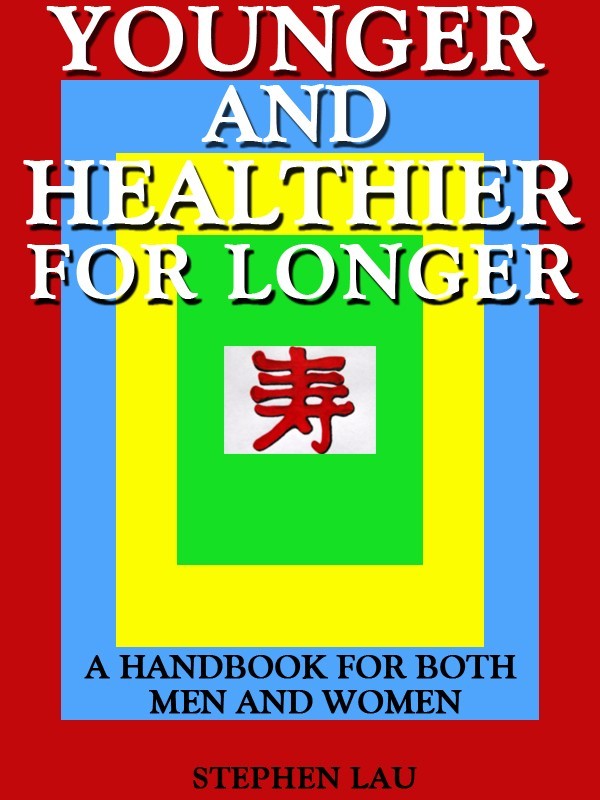






Wisdom in Aging
Younger and Healthier
Stephen Lau
Stephen Lau

AGING
The passage of time is inevitable and eternal. Aging begins as early as from young adulthood (around age 20 to 40) to middle adulthood (around age 40 to 65), and continues to old age (beginning at the age of retirement, approximately at age 65). Aging occurs throughout most of lifespan. Such a process is an accumulation of changes, which may be subtle or even drastic, that progressively lead to disease, degeneration, and, ultimately, death. Truly, you cannot die merely of old age; your ultimate demise is caused by advancing age itself, as well as by the diseases and degenerative conditions that accompany it.
Aging is difficult to define, but you will know it when you see it or experience it yourself. In brief, aging is a steady decline in health, which is instrumental in shortening lifespan; and the aging process is the duration during which such changes occur.
The hard facts of aging
Whether you like it or not, your biological clock is ticking, and this will happen to various systems in your body:
Your heart will pump less blood, and your arteries will become stiffer and less flexible, resulting in high blood pressure-a health problem that often increases with age.
With less oxygen and nutrients from the heart, your lungs will become less efficient in distributing oxygen to different organs and membranes of your body.
Your brain size will gradually reduce by approximately 10 percent between the age of 30 and 70. Loss of short-term memory will become more acute.
Your bone mass will reduce, making it more brittle and fragile. Your body size will shrink as you lose your muscle mass.
Can the aging process be slowed down?
Absolutely! Although death has been pre-programmed into your biological organisms, you body cells, theoretically, may have an indefinite lifespan through division, rejuvenation, and regeneration-if they are still healthy and functional.
Although your genes mainly determine the speed of your biological clock, you can still slow down the speed of aging-if you still have good health.
So, what is good health? Is being healthy synonymous with absence of disease?
According to the United States Public Health Service, good health is “preventing premature death, and preventing disability, preserving a physical environment that supports human life, cultivating family and community support, enhancing each individual’s inherent abilities to respond and to act, and assuring that all Americans achieve and maintain a maximum level of functioning.” This statement probably sums up what you need to do in order to be younger and healthier for longer; it says everything about aging.
Younger and Healthier for Longer focuses on preventive and remedial measures you can take to slow down your own aging process in order to attain your goal to become younger and healthier for longer.
Over the past decades, preventive medicine has become an important component of the health care system in the United States due to the rising cost of medical care and insurance coverage.
You need to develop your own preventive strategies to slow down, if not reverse, your own aging process. Nobody can do it for you. But, with the help of this book, YOU can do it for yourself.
Remember, each individual’s aging process is unique in itself. This is most evident when you go to your high school reunion: some may look incredibly young, while others may have added ten to fifteen years to their age. A high school or college reunion is often a time of awakening and reckoning to one’s aging process.
Stephen Lau
Copyright© by Stephen Lau
The passage of time is inevitable and eternal. Aging begins as early as from young adulthood (around age 20 to 40) to middle adulthood (around age 40 to 65), and continues to old age (beginning at the age of retirement, approximately at age 65). Aging occurs throughout most of lifespan. Such a process is an accumulation of changes, which may be subtle or even drastic, that progressively lead to disease, degeneration, and, ultimately, death. Truly, you cannot die merely of old age; your ultimate demise is caused by advancing age itself, as well as by the diseases and degenerative conditions that accompany it.
Aging is difficult to define, but you will know it when you see it or experience it yourself. In brief, aging is a steady decline in health, which is instrumental in shortening lifespan; and the aging process is the duration during which such changes occur.
The hard facts of aging
Whether you like it or not, your biological clock is ticking, and this will happen to various systems in your body:
Your heart will pump less blood, and your arteries will become stiffer and less flexible, resulting in high blood pressure-a health problem that often increases with age.
With less oxygen and nutrients from the heart, your lungs will become less efficient in distributing oxygen to different organs and membranes of your body.
Your brain size will gradually reduce by approximately 10 percent between the age of 30 and 70. Loss of short-term memory will become more acute.
Your bone mass will reduce, making it more brittle and fragile. Your body size will shrink as you lose your muscle mass.
Can the aging process be slowed down?
Absolutely! Although death has been pre-programmed into your biological organisms, you body cells, theoretically, may have an indefinite lifespan through division, rejuvenation, and regeneration-if they are still healthy and functional.
Although your genes mainly determine the speed of your biological clock, you can still slow down the speed of aging-if you still have good health.
So, what is good health? Is being healthy synonymous with absence of disease?
According to the United States Public Health Service, good health is “preventing premature death, and preventing disability, preserving a physical environment that supports human life, cultivating family and community support, enhancing each individual’s inherent abilities to respond and to act, and assuring that all Americans achieve and maintain a maximum level of functioning.” This statement probably sums up what you need to do in order to be younger and healthier for longer; it says everything about aging.
Younger and Healthier for Longer focuses on preventive and remedial measures you can take to slow down your own aging process in order to attain your goal to become younger and healthier for longer.
Over the past decades, preventive medicine has become an important component of the health care system in the United States due to the rising cost of medical care and insurance coverage.
You need to develop your own preventive strategies to slow down, if not reverse, your own aging process. Nobody can do it for you. But, with the help of this book, YOU can do it for yourself.
Remember, each individual’s aging process is unique in itself. This is most evident when you go to your high school reunion: some may look incredibly young, while others may have added ten to fifteen years to their age. A high school or college reunion is often a time of awakening and reckoning to one’s aging process.
Stephen Lau
Copyright© by Stephen Lau
SKIN AGING
Intrinsic aging
Intrinsic aging is caused by internal factors in your body, some of which are beyond your control.
Cessation or interruption of skin cell replication
Your skin cells divide and replicate continually. However, after a while, they stop the replication process. Surprisingly, the skin cells do not perish; instead, they accumulate in your skin and secrete substances that further interrupt the natural renewal process of other healthy skin cells. Such interruption adversely affects the level of collagen, which is the most abundant protein in your body. Given that collagen makes up approximately six percent of your body weight, its breakdown takes away support of the skin, and thus causing fine wrinkles to appear on your face.
Decline of hormone production
In chronological aging, your body’s production of hormones declines as you age.
If you are a woman, your estrogen (hormones) level may decline by as much as 30 percent during the first ten years of menopause. This significant loss of estrogen not only causes your skin to become thinner and less elastic, but also prolongs the renewal process of your normal skin cells.
Change in physical structure of the face
Over time, the physical structure of your face changes due to the loss of bone mass and the decline in the volume of fat under the skin.
Stress
Stress may cause the flare up of acne, eczema (red swollen skin), and rosacea (a chronic skin disease in people with fair or light skin)-they damage skin texture.
Extrinsic aging
Extrinsic aging is often within your control because the contributing factors are no more than a reflection of your lifestyle.
Photo aging
The sun’s UVA and UVB rays cause irreparable damage to your skin, known as photo aging. Sunrays promote the growth of free radicals in your skin. Free radicals are damaging agents to youthful skin: they are responsible for the reduction of collagen (protein under your skin), causing your skin to become thin and loose; they accelerate the release of copper and iron from your skin cells, and thus promoting the growth of more free radicals.
Remember, going for that tanned look often comes with a hefty price.
Tobacco smoke
The nicotine in tobacco generates free radicals, which damage your skin.
Quit smoking immediately. Smoking is no longer “cool” when you look much older than your chronological age.
Excess alcohol consumption
Too much alcohol damages your liver. A dysfunctional liver cannot efficiently remove body toxins and waste products accumulated in your skin, and a damaged liver gives you a yellowish complexion, instead of a healthy glow.
Always drink moderately. More importantly, learn how to cleanse your liver to rid your body of toxic waste materials.
Pollutants from the water
Install a filter system (e.g. a home reverse-osmosis drinking water system) to filter out chemicals and pollutants from the water you use for drinking and bathing. Do not buy bottled water (unsafe plastic bottles).
Poor diet
Avoid all processed foods, which are loaded with chemicals, such as food colorings, food emulsifiers, and food preservatives, among other chemicals.
Go organic and eat only super foods. Eat a balanced diet with abundant antioxidant vitamins (vitamins A, C, and E) to ameliorate the oxidative stress of free radicals, which are the main agents for skin aging.
Dehydration
Dehydration dries up your skin. Water and body fluids form a major component of your body. They serve several important functions for your skin:
Cushioning skin cells for protection against external damage
Flushing out toxins through your sweat glands
Enhancing communication between skin cells, thereby maintaining skin sensitivity
Moistening skin tissues to prevent problems of dry skin
Transporting nutrients and oxygen to skin cells
Research studies have shown that 75 percent of Americans are chronically dehydrated due to the following reasons:
Dry artificially heated or cooled living environment
Regular consumption of dehydrated beverages, such as alcohol, caffeine, and carbonated sodas
Install a humidifier in your home.
Eat more fruits and vegetables. Your body produces water when it turns foods into energy. At least 25 percent of your daily water requirement should come from fruits and vegetables. Of course, drink only pure water, and drink more-not just eight glasses!
Wind and heat
Extreme wind and heat may also damage your skin, especially in a work environment outdoor, or with regular close proximity to fire, furnace, and stove, such as working in a kitchen.
Protect your skin from dehydration with lubricant, such as Vaseline pure petroleum jelly (no need for expensive body creams and lotions).
Gravity
Gravity, over time, weighs down your skin, causing it to sag. Gravity begins to have its toll on your face in your 40s and 50s.
To sum up, your lifestyle has an impact on not only your overall health but also the youthful look of your skin. Remember, in your 20s, you have the face that Nature gives you; in your 40s and 50s, you have the face that you might rightly deserve due to your lifestyle.
Stephen Lau
Copyright© by Stephen Lau
Intrinsic aging
Intrinsic aging is caused by internal factors in your body, some of which are beyond your control.
Cessation or interruption of skin cell replication
Your skin cells divide and replicate continually. However, after a while, they stop the replication process. Surprisingly, the skin cells do not perish; instead, they accumulate in your skin and secrete substances that further interrupt the natural renewal process of other healthy skin cells. Such interruption adversely affects the level of collagen, which is the most abundant protein in your body. Given that collagen makes up approximately six percent of your body weight, its breakdown takes away support of the skin, and thus causing fine wrinkles to appear on your face.
Decline of hormone production
In chronological aging, your body’s production of hormones declines as you age.
If you are a woman, your estrogen (hormones) level may decline by as much as 30 percent during the first ten years of menopause. This significant loss of estrogen not only causes your skin to become thinner and less elastic, but also prolongs the renewal process of your normal skin cells.
Change in physical structure of the face
Over time, the physical structure of your face changes due to the loss of bone mass and the decline in the volume of fat under the skin.
Stress
Stress may cause the flare up of acne, eczema (red swollen skin), and rosacea (a chronic skin disease in people with fair or light skin)-they damage skin texture.
Extrinsic aging
Extrinsic aging is often within your control because the contributing factors are no more than a reflection of your lifestyle.
Photo aging
The sun’s UVA and UVB rays cause irreparable damage to your skin, known as photo aging. Sunrays promote the growth of free radicals in your skin. Free radicals are damaging agents to youthful skin: they are responsible for the reduction of collagen (protein under your skin), causing your skin to become thin and loose; they accelerate the release of copper and iron from your skin cells, and thus promoting the growth of more free radicals.
Remember, going for that tanned look often comes with a hefty price.
Tobacco smoke
The nicotine in tobacco generates free radicals, which damage your skin.
Quit smoking immediately. Smoking is no longer “cool” when you look much older than your chronological age.
Excess alcohol consumption
Too much alcohol damages your liver. A dysfunctional liver cannot efficiently remove body toxins and waste products accumulated in your skin, and a damaged liver gives you a yellowish complexion, instead of a healthy glow.
Always drink moderately. More importantly, learn how to cleanse your liver to rid your body of toxic waste materials.
Pollutants from the water
Install a filter system (e.g. a home reverse-osmosis drinking water system) to filter out chemicals and pollutants from the water you use for drinking and bathing. Do not buy bottled water (unsafe plastic bottles).
Poor diet
Avoid all processed foods, which are loaded with chemicals, such as food colorings, food emulsifiers, and food preservatives, among other chemicals.
Go organic and eat only super foods. Eat a balanced diet with abundant antioxidant vitamins (vitamins A, C, and E) to ameliorate the oxidative stress of free radicals, which are the main agents for skin aging.
Dehydration
Dehydration dries up your skin. Water and body fluids form a major component of your body. They serve several important functions for your skin:
Cushioning skin cells for protection against external damage
Flushing out toxins through your sweat glands
Enhancing communication between skin cells, thereby maintaining skin sensitivity
Moistening skin tissues to prevent problems of dry skin
Transporting nutrients and oxygen to skin cells
Research studies have shown that 75 percent of Americans are chronically dehydrated due to the following reasons:
Dry artificially heated or cooled living environment
Regular consumption of dehydrated beverages, such as alcohol, caffeine, and carbonated sodas
Install a humidifier in your home.
Eat more fruits and vegetables. Your body produces water when it turns foods into energy. At least 25 percent of your daily water requirement should come from fruits and vegetables. Of course, drink only pure water, and drink more-not just eight glasses!
Wind and heat
Extreme wind and heat may also damage your skin, especially in a work environment outdoor, or with regular close proximity to fire, furnace, and stove, such as working in a kitchen.
Protect your skin from dehydration with lubricant, such as Vaseline pure petroleum jelly (no need for expensive body creams and lotions).
Gravity
Gravity, over time, weighs down your skin, causing it to sag. Gravity begins to have its toll on your face in your 40s and 50s.
To sum up, your lifestyle has an impact on not only your overall health but also the youthful look of your skin. Remember, in your 20s, you have the face that Nature gives you; in your 40s and 50s, you have the face that you might rightly deserve due to your lifestyle.
Stephen Lau
Copyright© by Stephen Lau

SAVING YOUR FACE
Unfortunately, the skin aging process cannot be reversed.
You can only fix your face through non-surgical procedures, such as BotoxÒ and RestylaneÒ, and other invasive surgical procedures, such as a face-lift.
BotoxÒ
BotoxÒ has been hailed as “the new fountain of youth” or the magic potion to aging.
Can BotoxÒ really save your face?
The pros of BotoxÒ are as follows:
BotoxÒ is a purified protein injected into your skin to make your muscles contract, and hence smoothing out your crows’-feet lines around your eyes.
BotoxÒ is minimally invasive, much better than invasive plastic surgery.
BotoxÒ is an instant fix: you can see the results almost immediately.
BotoxÒ gives a more natural look, except for the lines around the mouth. This is the reason why BotoxÒ is generally not applied on the smile folds because it weakens the muscle around the mouth, making your smile look “unnatural.”
BotoxÒ is a fairly safe and an ideal procedure because the botulimum (a toxic chemical) in BotoxÒ is extremely low, and there is little or no buildup of the toxin in your body (often eliminated within 24 to 48 hours-or at least according to BotoxÒ) to pose any major health risk.
BotoxÒ is relatively inexpensive, compared to other invasive procedures, such as a face-lift.
The cons of BotoxÒ are as follows:
BotoxÒ paralyzes your facial muscles, and therefore cannot fix your smile folds, making your smile seem “unnatural.”
BotoxÒ is still costly long term: the procedure has to be repeated every three to four months.
BotoxÒ is a drug with botulimum (a toxic chemical), and you may still have some concern about injecting it into your body.
Collagen injections
Besides BotoxÒ, there are other non-surgical procedures for consideration to save your face.
Collagen is a protein substance in the dermis layer of your skin, which is responsible for your skin’s elasticity. Collagen injections use bovine collagen, which is pure collagen obtainable from isolated cows, and which is clinically tested prior to injection.
Collagen injections have the following advantages:
Collagen injections make the lines on the face become less obvious and much smoother, but they do not make the lines disappear completely as BotoxÒ does.
Collagen injections are used mainly between the eyebrows and on smile folds, where BotoxÒ does not work effectively.
The disadvantages of collagen injections are as follows:
Collagen injections are not for everyone, especially if you are allergic to cows.
Collagen injections only soften your lines: they do not remove them completely.
Fat injections
Fat injections are living grafts in which part of the fat from your own body, usually from the buttocks, stays and lives in a new environment.
Fat injections have the following advantages, compared to other non-surgical procedures:
They are more cost effective, compared to other non-surgical procedures.
The intervals between injections can be up to several months.
Fat injections may be the best option for deep smile folds, much more effective than collagen injections.
RestylaneÒ
RestylaneÒ is a clear gel injected into your skin to soften your facial contours, and to remove lines and wrinkles on your face. It is derived from a product as bio-compatible and bio-degradable as the natural hyaluronic acid, which is naturally found in your body. Hyaluronic acid, present mainly in your skin, is a substance that gives your body its structure and volume by attracting and holding on to the water in your skin. As such, it is most ideal for line and wrinkle filler.
RestylaneÒ has the following advantages over other similar products to remove wrinkles:
RestylaneÒ does not paralyze your facial muscles. It can be injected almost anywhere on your face.
RestylaneÒ eliminates any rejection risk by your body because it is naturally found in your own body.
RestylaneÒ lasts longer (up to a year) than collagen injections. It is, therefore, more cost effective in the long haul, although it costs 40 to 50 percent more than a collagen injection does.
According to the American Society for Aesthetic Plastic Surgery, every year thousands of individuals opt for cosmetic procedures to save their faces, and of these individual in quest for a youthful look about 88 percent are women and 12 percent are men. However, cosmetic procedures only temporarily fix the problems of skin aging. Having a youthful look is more than just skin deep, and it never comes easy.
Just remember the following:
Your face is not you.
Your youthful look is only a part of you, and it is bound to change, no matter what. Learn how to delay, but also to accept, that inevitable change on your look.
Nobody’s face is perfect-let alone yours.
Do what you can, but do it!
Your over-concern for face image will level off at around fifties and sixties, when you would be more concerned with your health than with your youthfulness. This is the reality of life!
Stephen Lau
Copyright© by Stephen Lau
Unfortunately, the skin aging process cannot be reversed.
You can only fix your face through non-surgical procedures, such as BotoxÒ and RestylaneÒ, and other invasive surgical procedures, such as a face-lift.
BotoxÒ
BotoxÒ has been hailed as “the new fountain of youth” or the magic potion to aging.
Can BotoxÒ really save your face?
The pros of BotoxÒ are as follows:
BotoxÒ is a purified protein injected into your skin to make your muscles contract, and hence smoothing out your crows’-feet lines around your eyes.
BotoxÒ is minimally invasive, much better than invasive plastic surgery.
BotoxÒ is an instant fix: you can see the results almost immediately.
BotoxÒ gives a more natural look, except for the lines around the mouth. This is the reason why BotoxÒ is generally not applied on the smile folds because it weakens the muscle around the mouth, making your smile look “unnatural.”
BotoxÒ is a fairly safe and an ideal procedure because the botulimum (a toxic chemical) in BotoxÒ is extremely low, and there is little or no buildup of the toxin in your body (often eliminated within 24 to 48 hours-or at least according to BotoxÒ) to pose any major health risk.
BotoxÒ is relatively inexpensive, compared to other invasive procedures, such as a face-lift.
The cons of BotoxÒ are as follows:
BotoxÒ paralyzes your facial muscles, and therefore cannot fix your smile folds, making your smile seem “unnatural.”
BotoxÒ is still costly long term: the procedure has to be repeated every three to four months.
BotoxÒ is a drug with botulimum (a toxic chemical), and you may still have some concern about injecting it into your body.
Collagen injections
Besides BotoxÒ, there are other non-surgical procedures for consideration to save your face.
Collagen is a protein substance in the dermis layer of your skin, which is responsible for your skin’s elasticity. Collagen injections use bovine collagen, which is pure collagen obtainable from isolated cows, and which is clinically tested prior to injection.
Collagen injections have the following advantages:
Collagen injections make the lines on the face become less obvious and much smoother, but they do not make the lines disappear completely as BotoxÒ does.
Collagen injections are used mainly between the eyebrows and on smile folds, where BotoxÒ does not work effectively.
The disadvantages of collagen injections are as follows:
Collagen injections are not for everyone, especially if you are allergic to cows.
Collagen injections only soften your lines: they do not remove them completely.
Fat injections
Fat injections are living grafts in which part of the fat from your own body, usually from the buttocks, stays and lives in a new environment.
Fat injections have the following advantages, compared to other non-surgical procedures:
They are more cost effective, compared to other non-surgical procedures.
The intervals between injections can be up to several months.
Fat injections may be the best option for deep smile folds, much more effective than collagen injections.
RestylaneÒ
RestylaneÒ is a clear gel injected into your skin to soften your facial contours, and to remove lines and wrinkles on your face. It is derived from a product as bio-compatible and bio-degradable as the natural hyaluronic acid, which is naturally found in your body. Hyaluronic acid, present mainly in your skin, is a substance that gives your body its structure and volume by attracting and holding on to the water in your skin. As such, it is most ideal for line and wrinkle filler.
RestylaneÒ has the following advantages over other similar products to remove wrinkles:
RestylaneÒ does not paralyze your facial muscles. It can be injected almost anywhere on your face.
RestylaneÒ eliminates any rejection risk by your body because it is naturally found in your own body.
RestylaneÒ lasts longer (up to a year) than collagen injections. It is, therefore, more cost effective in the long haul, although it costs 40 to 50 percent more than a collagen injection does.
According to the American Society for Aesthetic Plastic Surgery, every year thousands of individuals opt for cosmetic procedures to save their faces, and of these individual in quest for a youthful look about 88 percent are women and 12 percent are men. However, cosmetic procedures only temporarily fix the problems of skin aging. Having a youthful look is more than just skin deep, and it never comes easy.
Just remember the following:
Your face is not you.
Your youthful look is only a part of you, and it is bound to change, no matter what. Learn how to delay, but also to accept, that inevitable change on your look.
Nobody’s face is perfect-let alone yours.
Do what you can, but do it!
Your over-concern for face image will level off at around fifties and sixties, when you would be more concerned with your health than with your youthfulness. This is the reality of life!
Stephen Lau
Copyright© by Stephen Lau


